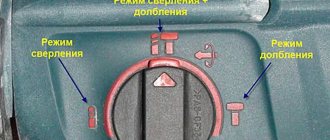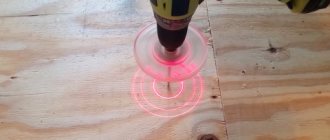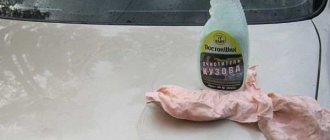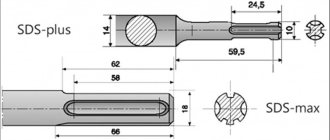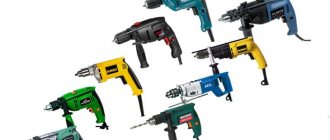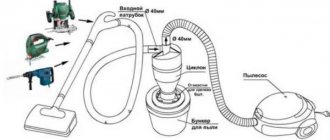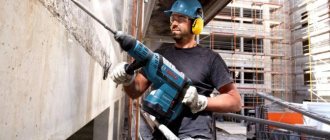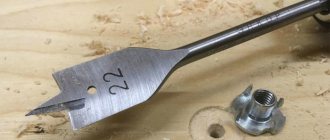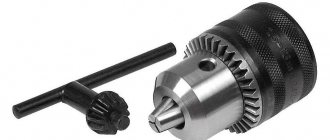Is it possible to drill concrete with a screwdriver?
To answer this question, you should know in what material you need to drill holes, what depth and diameter. Holes with a diameter of 10 mm or more are problematic to make using a screwdriver. But if the drill is thin (3-5 mm), then you can drill with such elements using a screwdriver. The rotation speed of the drill affects the ability to drill in hard materials. For screwing, a rate of 500 rpm is suitable, and you can drill concrete using equipment with a head torsion speed of 1300-1500 rpm. The torque is also more important, and specifically, what force is applied to tighten the screws or the drilling process. For concrete, choose a screwdriver with a power of 140 N/m, using it in the last working position of the coupling at the highest power.
Can I drill with a screwdriver? — EcommerceMarket.ru
Manufacturers offer a variety of tools. Almost everyone can choose a tool to suit their financial capabilities and technical needs. A screwdriver is becoming increasingly common in the home workshop. Therefore, questions arise about what else can be done with its help. Today we’ll figure out whether it’s possible to drill with a screwdriver?
Experts do not recommend working with concrete. Even a drill with good technical characteristics may not be able to handle such hard material. But, if your model has an impact function, then you can try to overcome thin concrete, stone or brick. As a rule, modern structures are built from aerated concrete or sand-lime brick. Such surfaces can be drilled with the most ordinary model, which does not contain an impact function. The main thing is to use the right drill.
What can a screwdriver handle without problems? If you plan to work with wood, plaster, metal or plywood, then you can safely take out the tool. It will help not only tighten screws, but also be useful for drilling.
How to choose a tool?
To safely use a drilling device, you must choose it correctly. What should you pay attention to? If you want it to always be ready for use, then buy a network device or a battery-powered one, but with a spare battery. The ability to drill various materials is affected by the rotation speed. For example, for tightening, 500 rpm is sufficient. For the drilling function, the speed should reach 1300 rpm. It is also important to pay attention to torque. If it is small, then such a screwdriver is only suitable for drilling wood.
How to save on a hammer drill and drill a concrete wall with a regular drill?
Many people live in houses with concrete walls, and when it comes to making a hole in them, they face severe difficulties.
Don’t despair and be upset if you didn’t manage to hang a shelf, lighting fixture or cabinet right away, read our tips and everything will work out.
There are several options with which you can drill through a concrete wall without the help of others.
Useful
How to drill concrete and brick with a screwdriver
DeWALT DCD985M2
The difference between this screwdriver is:
- the most powerful impact mechanism (drilling 13/60 mm holes in concrete, 16 mm in stone);
- 3-speed gearbox, the speed of which is regulated by the consumer;
- for the rotating mode, you can select 1 suitable combination out of 22;
- a speed block integrated into the tool gives additional control over the process;
- LED lighting;
- a specially designed chuck for drilling various materials;
- functionality (tightly intertwined with technical characteristics);
- compatibility with fasteners for drilling metal/wood/stone/concrete.
Hammer
When using a hammer drill or impact drill, they need to be switched to impact mode, a working tool with a pobedite tip is inserted and it must be oriented perpendicular to the wall surface.
If drilling holes is carried out for a long time, then from time to time you need to wet the drill so that it does not overheat too much.
After you have drilled to the desired depth, you need to stretch the working tool back without turning off the hammer drill. To clean the finished hole from dust, you need to deepen and remove the drill a couple of times.
Our services
Is it possible to do without a drill and hammer drill?
Make a hole without a drill or hammer drill, but not in a concrete wall. To do this you will need a bolt or a punch.
A bolt is a pipe with teeth at the end. The punch has an end in the form of a chisel or a tetrahedron.
The working end of the tool is applied to the place where the hole will be. On the opposite side of it, you need to strike hard, rotating the tool after each turn.
Tips for drilling concrete
Before drilling, it is necessary to carry out some manipulations with the tool. I advise you to carefully check the drill chuck for contamination, which, if detected, must be removed as soon as possible using a piece of dry rag.
READ How to cut brick at home
If you neglect this condition, then while you are drilling, various problems with the serviceability of the tool may arise. When inserting a drill into the chuck, make sure that it enters at a right angle and that the shank rests against the bottom of the chuck, otherwise the wall will remain untouched.
Indeed, the most serious problem that a concrete wall can present is the presence of metal reinforcement on the wall. Most often, such situations occur when concrete is drilled to a great depth. In this case, the reinforcement is processed with a punch, after which you can continue drilling.
Another option for solving this problem, when, for example, a concrete floor is covered with metal reinforcement, is to use a metal drill, which can easily be added to any impact drill.
Due to the fact that it is impossible to drill for longer than fifteen minutes using the tool used at home, you must take a break of the same duration every quarter of an hour. During this break, both the concrete and the tool used are cooled. One of the features of starting a tool to work on a concrete fault after such a break is treating the drill with water. For example, a screwdriver with a drill moistened with water is guaranteed to last longer, having completed a huge number of work tasks.
Often, during the drilling process, the wall begins to crumble on the other side. Simply put, the concrete layer separates the plaster layer from itself. Such processes should be avoided at all costs, as they can lead to the concrete layer being damaged and the process of its destruction beginning.
To preserve concrete in its original form, you only need to slightly slow down the speed of the tool, thereby reducing the intensity of its impact on the wall. This precaution ensures that the concrete layer of the wall remains intact.
Another trouble that happens when a drill is processing a concrete layer of a wall is the drill getting stuck. Under no circumstances try to remove it by actively loosening the tool in the wall. Not only will this cause the concrete layer of the wall to collapse, but the tip, the upper part of the tool, may also break off.
The equipment must be disconnected as carefully as possible, replace the drill with a smaller one and begin drilling the concrete around the stuck one. This procedure may take a long time, but it will preserve not only the integrity of the wall and the functionality of the stuck drill after it is removed.
So, in our article we looked in detail at how to drill a concrete wall. With the right selection of tools and functional components for them, you can easily make holes in concrete. Moreover, this work will be done with the highest quality, without extra costs and very quickly.
Drills - what are they?
Let's look at each of them separately.
How to drill concrete and brick with a screwdriver
Sources:
https://crast.ru/instrumenty/mozhno-li-shurupovertom-prosverlit-betonnuju-stenu https://xnb1afbusfheq.xnp1ai/kirpich/mozhno-li-sverlit-shurupovertom-kirpich.html
Manufacturers of hand tools: TOP 4 popular devices
DeWALT DCD985M2
The type of device is a drill-driver with impact mode, made in the shape of a pistol, equipped with a quick-release chuck, backlight and motor brake. Properties of the presented model:
- Silent 3 high speed iron gearbox.
- Battery - Li-Ion 18 V.
- Torque - 80 Nm.
- Beats per minute - 34,000 beats/min.
- Weight - 2.4 kg.
- Rotation speed - 2000 rpm.
- The largest drilling Ø for concrete is 16 mm.
Design and characteristics
From the outside, as well as from the mechanical action, the screwdriver resembles a drill. The difference is the low rotation speed/high scrolling torque. In addition, screwdrivers have fixed speed characteristics (on drills they are adjusted independently). Control over speed is necessary for safe and high-quality operation of the tool. The cartridge stops moving at the moment when the self-tapping screw is completely tightened. Despite the cartridge stopping, the engine is still in action.
A specific speed/mode of operation is designed for a particular type of work. There is a function for reverse, tightening, unscrewing screws (also nuts, screws, screws, soft materials). Craftsmen use screwdrivers all the time. In some cases (working with drywall, assembling an interior, creating a partition), the tool increases the speed and productivity of work several times.
Diagram of a cordless screwdriver.
Screwdrivers are designed on the same principle. Design basis:
- pistol-shaped handle (for working with the leading hand);
- little weight;
- a start key that starts/controls rotations;
- power source - mains or battery (note that the battery is more massive and more expensive than the tool itself);
- capacity is limited by the total weight of the tool;
- continuous operation time - about 3 hours;
- Spare battery available (depending on model).
DeWALT DCD985M2
The difference between this screwdriver is:
- powerful impact mechanism (drilling 13/60 mm holes in concrete, 16 mm in stone);
- 3-speed gearbox, the speed of which is regulated by the consumer;
- for the torque mode, you can select 1 desired combination out of 22;
- the rotation speed block built into the tool gives additional control over the process;
- LED lighting;
- specially designed chuck for drilling a variety of materials;
- functionality (closely related to technical characteristics);
- Compatible with fasteners for drilling metal/wood/stone/ concrete .
Is it possible to drill?
You can use a tool instead of a drill only if such a possibility is indicated in the technical data sheet of the device.
READ How to Drill a Hole Without a Drill
However, soft materials such as drywall can be drilled even with a low-power screwdriver .
To do this, instead of a bit, you need to insert a drill into the chuck for working with plasterboard.
To remove the drill or other attachments, you need to unscrew the chuck by hand or with a key. You also need to move the coupling to the appropriate position; usually this mode shows a drill icon. The nozzle is placed at a right angle to the marked surface. It is not recommended to deviate - this will complicate the movement of the drill and increase the diameter of the hole being made.
To drill a concrete or brick wall or tile, you will need a tool with a high rotation speed (from 1200 rpm) and high torque. Impact screwdrivers do the job more efficiently and quickly.
Important! A screwdriver is different from a drill and hammer drill, and should not be used for drilling a large number of holes. You need to take breaks during work so that the tool does not fail due to overheating.
A screwdriver that can drill concrete: myth or reality
Origin of screwdrivers
Each tool is created to solve a specific range of problems.
Therefore, it is worth starting to consider this issue with a brief excursion into history. It begins with the appearance in Ancient Rome of hand drills, which were driven by rotating the handle. Much later, only in the 19th century, electric drills were created, which increased the drilling speed tens of times due to the higher rotation speed of the electric motor compared to manual rotation of the rotor or crank. Further evolution developed by “crossing” electric drills with other types of tools. We “cross” a drill with a jackhammer by including an impact mechanism in its design - we get a hammer drill. We change the gear ratio in order to reduce the speed and not tear off the heads or spoil the slots of screws and self-tapping screws - we get a screwdriver.
| The evolution of the tool from the hand drill to the modern variety of devices. |
Why is a screwdriver bad at drilling concrete?
An ordinary electric screwdriver, although it is a type of drill, is structurally “tailored” for other tasks. The key difference is the reduced chuck rotation speed. The operating speed of simple single-speed screwdrivers, which are used in construction and manufacturing, usually does not exceed 750 rpm (compare this figure with the characteristics of electric drills, which have a chuck rotation speed of at least 2500 rpm). This speed is only sufficient for drilling brick (ceramic brick is usually drilled in modes from 400 - 600 rpm), but not enough for drilling concrete (the optimal rotation speed of inexpensive drills for concrete with a diameter of 10 - 13 mm lies in the range from 900 rpm to 1100 rpm).
But more importantly, a conventional single-speed screwdriver does not have an impact mechanism. Therefore, it cannot effectively crumble concrete or brick at the point of contact of the drill with the material. In addition, the design of the gearbox, bearing assembly and limit coupling does not imply significant axial loads. Therefore, using a conventional screwdriver, it is possible to drill concrete only theoretically, but in practice, attempts to drill dense structural materials usually end in lengthy and fruitless picking, as well as accelerated wear of the tool.
Popular drill-drivers with impact mode Interskol DAU-13/18V 574.2.2.70 from 5,290 rub. Interskol DAU-13/18V 574.4.1.70 from 6,600 rub. Makita HP0300 from 4,040 rub. Elitech DA 18 UBL2 191608 from 6,390 rub. Interskol DAU-13/18VK 573.2.2.70 from 5,387 rub. DeWALT DCD996P2 from RUR 34,072 DeWALT DCD996NT from RUR 13,690 DeWALT DCD706D2 from RUR 13,845 Makita HP457DWE from RUR 8,970 Interskol DAU-13/18VK 573.1.2.70 from 5,160 rub. Bosch GSB 12V-30 Professional 06019G9120 from 8,186 rub. Bosch GSB 180-LI Professional 06019F8323 from RUR 9,349 Bosch GSB 120-LI Professional 06019G8100 from RUR 5,716 Bosch GSB 18V-50 Professional 06019H5120 from RUR 13,350 Makita DHP484Z from RUR 8,324 DeWALT DCD796NT from RUR 11,398 Metabo SB 18 LT BL 602316550 from RUR 17,064 Makita DHP481RTE from RUR 30,236 Bosch GSB 18V-50 Professional 06019H5102 from 6,467 rub. DeWALT DCD776S2 from RUB 10,013.
Drills/drivers and concrete drilling
Fortunately, the “evolution tree” of hand-held power tools has a “side branch” in the form of drills and screwdrivers, which are represented by a large assortment of corded and cordless models. They are the ones who can (with some reservations and stretches) drill concrete.
To confidently and quickly drill concrete using a drill-driver, you need:
- sufficient power - to drill durable structural materials you need a tool with a power of 750 W or more;
- impact mode - the function of axial impact, combined with rotation of the cartridge, allows you to effectively destroy concrete at the point of contact;
- powerful battery - a cordless tool must be equipped with a battery with high current output in order to confidently rotate the drill in thick concrete;
- correct equipment - for drilling concrete walls and ceilings, you need special concrete drills with carbide tips or diamond coating.
| Special drills for concrete: DeWALT, Bosch and Hilti. |
The difference between the impact mechanisms of a screwdriver and a hammer drill
It’s worth dwelling separately on the shock mode. The design of the impact mechanism of a drill-driver is fundamentally different from the design of a similar hammer drill unit. There is no crank mechanism or “drunk” bearing inside the screwdriver, which would allow developing the high impact energy necessary for chiseling concrete. This function is implemented differently: the axial movement of the cartridge is created using two wavy washers (ratchets). When the engine rotates, the cartridge washer “jumps” along the protrusions of the stationary washer. A drill moves behind it, making reciprocating movements and crumbling the concrete a little at a time.
| Wavy washers in the impact mechanism of a DeWALT drill. |
The amplitude of movement of the drill tip is a fraction of a millimeter, and the impact force depends entirely on the force with which the operator presses on the tool. Therefore, the characteristics of drill-drivers do not indicate the maximum impact energy, and they are outright inferior to full-fledged hammer drills in terms of concrete drilling efficiency.
Inexpensive hammer drills
Kalibr Master EP-120M from RUR 2,200 Parma PE-01-20/600E from RUR 2,351 RedVerg Basic RH2-22 from RUR 2,490 Pobeda P-20-620 from RUR 2,546 Vihr P-550K from RUR 2,400 Doffler RH-0874 from RUR 2,443 Kolner KRH 520H from RUR 2,960 Wert ERH 0724HRE from RUR 2,466 Hiper HRH800A from RUR 3,700 Military RH500 from RUR 2,670 Patriot RH 231 140301231 from RUR 2,689 Bort BHD-720 from RUR 2,690 Patriot RH 160 Professional 140301160 from RUR 2,950 Bort BHD-700-P from 4,056 rub. Elitech P 0724 REM Promo from RUR 2,754 PIT PBH 24-C from 3,010 rub. DEKO DKH650W 063-4110 from RUR 2,789 Spec BPE-620 from RUR 3,843 Parma P-01-24/750ER from RUR 2,815 Hammer Flex PRT 650D from RUR 2,903
Limited tool capabilities
The possibilities of a screwdriver are far from limitless. Due to its technical characteristics, “tailored” for much simpler tasks, it will drill concrete five to ten times slower than drills and hammer drills that are more appropriate for this work. The diameter and depth of the holes that can be drilled with a screwdriver also leave much to be desired (the maximum size of the drill that can be clamped in the chuck allows you to drill holes for plastic dowels, but not for powerful anchors).
Therefore, a screwdriver is only suitable for occasionally making a hole in the wall. But it is simply not structurally designed for serial drilling of concrete. In order not to accidentally “kill” the tool when drilling a couple of holes for shelves or cornices, you need to have a little patience and beware of excessive loads on the engine and gearbox. Also, while working, you should monitor the temperature of the drill (if it gets too hot, the carbide tips may fall off) and allow it to cool in a timely manner.
Concrete is different from concrete
The concept of “concrete” covers a large number of materials. This includes lightweight cellular concrete (such as foam and aerated concrete blocks, which are used for laying external walls and internal partitions), and dense heavy concrete (used for pouring load-bearing frames of monolithic buildings and structures). There is a huge difference between them in density and strength. For example, the characteristics of typical aerated concrete blocks, from which the walls in your apartment or private house can be made, usually correspond to a strength class from B2.0 to B2.5. The strength of such a material does not exceed 25 - 35 kgf/cm2, which is significantly less than that of the cheapest M50 concrete. The strength of concrete grade M200, which is used for the construction of low-rise buildings, is much greater - up to 200 kgf/cm2. And in high-rise construction, concrete with a high cement content is used, the strength of which reaches 300 - 400 kgf/cm2. Therefore, even relatively inexpensive corded and cordless drills and screwdrivers with a power of up to 750 W can cope with drilling aerated concrete. But drilling dense reinforced concrete with granite filler is beyond the capabilities of even the most “advanced” models; this will require a powerful hammer drill with high impact energy.
| Internal structure of reinforced concrete. |
conclusions
There are screwdrivers that can drill into some types of graded concrete and concrete blocks. If you do not demand too much from them, then from time to time, using a drill-driver equipped with an impact mechanism, you can drill a couple of holes in a concrete wall. But this opportunity should be considered as a pleasant “bonus” to the main functions of this type of tool: tightening fasteners and drilling wood, plastic and metal.
And if we take into account the cost of the tool, then it is more profitable for an ordinary user to take a simple drill-driver with a two-speed gearbox and, in addition to it, a budget hammer drill than to buy an expensive professional screwdriver “for all occasions.”
How to drill a concrete wall - a possible way out of the situation
Sooner or later, most people living in houses with concrete walls need to hang a cabinet, lamp, shelf or picture. At this point, the pressing question arises of how to drill through a concrete wall. It's no secret that every home master has encountered this problem at least once in his life, but not everyone knows how to solve it. Many bravely torture the drill and their own strength, but, not achieving the desired result, they give up everything until the next attempt to make a hole in the wall. But the drill eventually breaks, and the shelves remain standing somewhere in the corner of the room or collecting dust in the pantry. But there are still options - you just need to know them and be able to use them.
How to choose a tool?
For a larger volume of work, you need a hammer drill or drill with an impact function and drills with pobedite tips. An impact drill combines rotational and reciprocating motion, which helps it cope well with lightweight concrete, and to the question of how to drill through a concrete wall, which is a load-bearing one, there is a simple answer - the best assistant will be a hammer drill, the main purpose of which is to punch through concrete fences. There is one more difference:
- an impact drill is designed to drill holes no more than 12 mm in diameter;
- The hammer drill is capable of drilling large holes.
Reinforcement found in the body of a concrete wall should be drilled using metal drills.
Tools
To drill a reinforced concrete surface, you need to use specialized tools - in our version, you won’t be able to get by with a homemade tool.
Based on your preference for the diameter of the hole, you can use a hammer drill, also called a small-sized electric hammer drill. What is the best way to drill a concrete wall in an apartment or panel house: a regular screwdriver with a drill, is it possible to make a hole in a concrete wall with a dust-free hammer drill, and how. Is it possible to drill with a screwdriver? “Is it possible. The first option has less power, but has less weight and an inconvenient design. The hammer drill, accordingly, has greater potential, weight and dimensions.
Read also: Welding in carbon dioxide with a consumable electrode
Be careful! Since the use of construction equipment is often one-time in nature, it is more rational to rent them. Considering that their price is quite high, this way you will save a considerable amount of money.
In addition to the existing tools, it is necessary to purchase special drill bits that allow you to work with a concrete surface. For a hammer drill, drills with a Pobedit tip are selected.
A hammer drill has its own weight characteristics and a set of impact attachments, which, in most cases, are quite enough . Drills with a tip are also used as additional components for the hammer drill.
Concrete drills
To form holes with a diameter of thirty-five to one hundred and twenty mm, crown bits are used, which have pobedite teeth - using them, grooves for sockets, switches, etc. are drilled. If you are deciding on the question of how to drill concrete with a screwdriver, then there are also tungsten carbide-coated crowns for this. However, please note that they are only suitable for units with a power of two or more than 1kW.
What do the professionals advise?
Concrete structures are quite strong and difficult to drill. In addition, quite often drills come across crushed stone, which is part of the concrete mixture from which wall and ceiling slabs are formed.
Holes in concrete have to be made quite often, especially during the process:
- finishing works;
- furniture installation;
- air conditioner suspensions;
- additional electrical wiring device;
- installation of plumbing.
There are two ways to solve the problem of holes in a concrete wall:
- an impact drill, or better yet a hammer drill, with a Pobedit drill bit;
- diamond drilling.
It is worth noting that it will not be possible to make a hole in a concrete wall with ordinary drills, so before starting work you need to purchase drills with specially soldered plates made of high-strength pobedit alloy, which do an excellent job with concrete and brick. But it is not recommended to use them for soft materials, since pobedit drills do not cut them, but crumble them.
Selecting suitable self-tapping screws for drilling
Self-tapping screws are fasteners in the form of a rod that have a screw thread, a pointed end and a head. The thread holds the screw shaft in the wall, thereby ensuring fixation and immobility. According to the classification, self-tapping screws for drilling are divided into the following types.
- Universal, suitable for any fastenings - the most common.
- Self-tapping screws that strengthen metal sheets without dowels. Before screwing in the self-tapping screw, drilling is mandatory.
- Self-tapping screws without dowels for fastening soft metal and wood, plastic.
- Self-tapping screws in the form of a herringbone, capable of strengthening a concrete or brick wall, going along with dowels, by driving inward.
- Dowels - self-tapping screws without dowels, are needed to strengthen a brick wall or a concrete wall.
To choose the right self-tapping screws for drilling, it is important to consider what metal or alloy they are made of. The scope of application of these products depends on the material of manufacture.
- Stainless steel. A huge advantage is protection from moisture. The presence of metals such as chromium and nickel prevents such screws from rusting.
- Carbon steel. Compared to the previous type, this metal is not protected from moisture, but is more durable.
- Brass self-tapping screws for drilling are a relatively expensive but high-quality material. They can be used in both salty and acidic environments. Brass is resistant to corrosion, but this alloy is soft and deforms under heavy load.
If you choose self-tapping screws for drilling in concrete with a dowel, you need to take into account that the capsule is first hammered into it, and the screw itself is screwed into it. The mechanism is made in such a way that the sharp ends of the capsule dig into the wall as the screw is screwed into the hole, expanding the fastening area for a more durable attachment.
This fastening system, where a plastic sleeve expands the fastening area, is used in the following cases:
- increased load on screws;
- more rigid fixation for cellular concrete;
- the need to eliminate vibrations to prevent screws from unwinding.
If you need to strengthen the structure in a facade building, you can use high-quality MBR-X facade dowels that come with a screw. Such fasteners can be screwed into a brick wall, and they are suitable for both solid and hollow bricks.
In the absence of a dowel, you will also need to drill a small hole for self-tapping screws; it is also better to calculate in advance the length of the screw to be passed through. Otherwise, the self-tapping screw will either not reach the required depth or will sink into the wall. Re-installation may only damage the fragile hole in the concrete.
There are also so-called turbo screws. The advantage of such a screw is the variable thread, which has notches. It has good adhesion to the concrete wall. Such self-tapping screws can be screwed in with a regular drill; they do not require excessive effort. The turboscrew is suitable for cellular and hollow concrete blocks.
The color of the screws is also important. In relation to color, drilling screws are as follows.
- Silver - these screws are suitable for any climatic conditions. Prevents the onset of corrosion. Suitable for work both indoors and outdoors.
- Yellow – covered with a protective zinc coating with an admixture of copper. Are used only for interior work.
- Black – contain an oxide film. Such screws are not suitable in rooms with a high percentage of humidity, for example, in bathhouses and greenhouses it is undesirable to use such fasteners.
When tightening self-tapping screws with a conventional drill, it is important to choose a drill, taking into account the following recommendations:
- the drill should be a couple of millimeters smaller than the self-tapping screw;
- when using a breaker tool, it is better to purchase a drill that has recesses on the clamping part of the drill;
- When drilling, you can use a universal brick drill bit for a drill.
In conclusion, I would like to note that drilling a brick wall is not difficult. The main thing is to adhere to the recommendations mentioned and select the right equipment for the job.
You will learn more about concrete drills from the video.
What will help the home handyman?
At home, when you need to make 2-3 holes in concrete, you can get by with a regular drill, without the impact function. the concrete from time to time with a strong metal pin (punch) matching in size to the diameter of the hole. It is used when the drill begins to “stick” in the wall. At this moment, a steel punch is inserted into the hole and they begin to hit it with a hammer or sledgehammer, trying to crush areas that are too dense and punch the hole deeper. In this case, the pin is turned a little. Then the hammerless drill can start working again.
All the above steps are repeated one after another until the hole increases to the required depth. This method is quite labor-intensive and tedious, but for a couple of holes it is quite acceptable.
Alternatively, when drilling a hole in concrete, you can use universal diamond-coated drills. They are highly effective when working with metal, crushed stone and concrete. They can only be installed on a conventional electric drill, or on a tool with the vibration function disabled.
You need to work with the drill extremely carefully, otherwise it will fail too quickly. The advice that professionals give is that to avoid overheating of the drill, it should be moistened with cold water from time to time.
How to make a hole in a brick wall
Before drilling into a brick wall, you need to check for electrical wiring. Then marking is carried out. You need to decide on the parameters of the recess. Depending on this, drills, drills or crowns will be selected.
Preparing tools
If you plan to use a drill, its power should not be less than 600 W, and the number of revolutions should be approximately 2500 or more. Make sure the equipment has a reverse function so you can adjust the power. Brick is resistant to static loads, so the equipment must have an impact option.
The material should be influenced dynamically, only then will it be possible to achieve results. This is why a household drill is not suitable for the process. If you still decide to take a risk and use such a device, you may be faced with the need to repair the drill, since its motor will certainly overheat and fail.
Preparatory work
In addition to electrical wiring, there should be no fittings in the wall. To find it, you should use a metal detector. If there is no tool to find the wiring, you need to make sure that it does not pass through the seams under the layer of plaster. To do this, before starting drilling, you need to deepen the seams a little.
Drilling holes in a brick wall
To make an even recess, you need to install the drill perpendicular to the wall. First, several short inclusions are made so that the equipment deepens a few millimeters. Next, you should begin the main process, removing the drill from time to time and allowing the drill to rest a little.
What do you use to drill large holes?
Professionals who are constantly faced with the problem of drilling holes in concrete use special equipment, which includes:
- powerful electric motor;
- drilling drive;
- diamond core drills of different diameters;
- a guide post fixed to the base.
Diamond drilling allows you to make holes of large diameter - up to 40 cm. The process occurs quite quickly, efficiently, without unnecessary dust and noise. Water is automatically supplied to the drilling site, which simultaneously cools the diamond bit and washes away dust.
When diamond drilling, the holes are precise in shape and clear in outline, with a polished inner surface. They can be made in various enclosing structures at any angle to the horizon, and the possibility of cracks or chips in the concrete is completely excluded. Destruction occurs only at the location of the future hole.
READ How to Make a Hole in Concrete Without a Hammer
Diamond drilling is carried out by specialized companies, so if necessary, you can invite specialists with their own equipment to drill And you don’t have to buy a diamond drilling machine specifically for this.
Expert advice
In order for you to correctly drill a concrete wall, you must have the necessary equipment, perform all work carefully and adhere to the following recommendations:
- without a hammer drill, the work can be done with an impact drill or drilled with a screwdriver ;
- do not buy cheap drills, as their pobedite tip falls off very quickly and they fail;
- instead of a punch, you can use a pobedit tool, with one you will break the crushed stone, and with the second, inserted into a regular electric drill, you will drill;
- to work with concrete, the hammer drill must have an SDS-plus chuck;
- take into account the placement of the reinforcement to determine where it is located, you can use a metal detector; if the reinforcement is exposed, it must be painted to prevent rusting;
- To work with concrete, you can use universal diamond-coated drills, but you need to insert them only into a regular drill, or you need to turn off the impact mode.
Diamond drilling
This is the most effective way to quickly and easily make a hole of the required diameter in a concrete wall.
To perform the above work, you will need special equipment consisting of the following elements:
- electric motor;
- a stand that is securely fixed to the base;
- core drill.
There is no need to cool the drill during operation, as water is supplied to it, which not only cools the tool, but also prevents dust from forming.
If specialists work, then together with the specified equipment they use a vacuum cleaner, with which they remove dust and water.
Since the price of such equipment is very high, it is not advisable to buy it for domestic use. If it is necessary to make a hole of a large diameter, you can always invite specialists for this.
READ How to Drill Through the Center of a Pipe Using a Drill
Choosing a power tool
To create small-diameter holes in small quantities, an impact drill or hammer drill with a power of up to 350 W is sufficient. Professionals involved in wiring communications in panel houses, brick cottages on a concrete foundation, use professional hammer drills or diamond machines.
hole cannot be obtained using a standard three-jaw chuck with a key collet clamp.
When passing through reinforcement, granite crushed stone, the clamping force will not be enough, the tool is guaranteed to begin to rotate in the chuck, wearing out the shank and cams.
Therefore, for large holes, an SDS chuck with a diameter of 10-18 mm is required. Slotting when creating holes with a crown is completely eliminated; the hammer drill must have such a function.
HOW TO DRILL A HOLE IN CONCRETE?
Holes in concrete are necessary for conducting and installing communications. The work is characterized by an abundance of dust, noise, high labor costs, and requires high-quality power tools. To drill a hole in this material, Honor follows that every hole in the building’s load-bearing frame reduces its strength, is fraught with damage to the engineering systems located inside (mainly electrical wiring, ventilation ducts), and is dangerous.
Through holes with low quality tools cause adjacent sections of walls to crumble at the exit of the drill/bit from their reverse side. Additional finishing is required, the work time increases.
Do-it-yourself technologies for making holes in concrete
In the process of construction and finishing of buildings, the need arises to produce blind or through holes of different diameters. Blind holes are created for fastening, their diameter is limited to 2-16 mm. In this case, an important factor is compliance with the declared diameter. Otherwise, in broken holes, plastic dowels for self-tapping screws and nails will become loose over time, reducing the strength of fixation of wall cabinets, curtains, pipelines, and decorative elements.
To drill blind holes of large diameter or through penetration of reinforced concrete walls to enter communications, crowns are used. They are a cylinder, one side of which is attached with a shank to the chuck of a drill or hammer drill, the second has pobedite or diamond bits welded to it. A Victory drill is installed in the middle part of the structure to provide direction.
Drilling with a drill or drill leads to the destruction of the entire volume of concrete at the point of contact of the tool with the structural material. If there is reinforcement inside the reinforced concrete structure, it is impossible to drill through it; the hole is moved to the side.
Drilling holes in concrete with a crown differs from the previous method:
- concrete is destroyed only around the perimeter of the hole;
- a concrete cylinder remains inside the crown.
Therefore, after reaching the required depth of the blind hole, the inner concrete cylinder remains connected to the wall at the rear end. To remove it from the hole, destructive methods are used: a chisel with a hammer or a hammer drill. Concrete cylinders during through drilling are removed from the tool by lightly hitting the body with a mallet
Drilling holes in concrete is done with the following tools:
- spiral impact drill - more often used for blind holes, the diameter of the carbide inserts of the tip is always larger than the spiral body of the tool, the shank is round, not intended for working in concrete with a hammer drill with SDS cartridges;
- spiral drill - instead of pobedite, a zirconium or tungsten tip (spraying) is used, the shank with grooves is suitable only for SDS chucks (Max, modifications), dust-free, low-noise drilling is ensured;
- A diamond bit is a large-diameter tool exclusively for high-speed rotary drilling.
The marking of a twist drill indicates the Caliber, not the diameter. This is the distance between the protruding edges of the solders/liners. Drilling holes with this tool is carried out in the following modes:
- 800-1200 revolutions for diameters within 4 mm;
- 300-500 revolutions for diameters 5-13 mm.
Even the presence of a red marking on the tip of this tool does not guarantee that the tip material matches the metal declared by the manufacturer. Cheap substandard equipment, upon first use, develops into an incomprehensible configuration and becomes unsuitable for work.
Zirconium and tungsten drills are suitable for the following operating modes:
- 60-100 revolutions with a diameter of 42-76 mm;
- 150-400 revolutions for diameters 4-60 mm.
The length of the drill can reach 1 m; a small amount of dust when working with this tool allows you not to remove the furniture from the room. The destroyed concrete “flows” out of the hole in a stream through spiral channels and is collected on the underlying film or paper.
Professionals make blind holes for large diameter socket boxes in a few seconds. A home craftsman who does not regularly practice working with such a tool most often runs the risk of damaging the crown at the slightest misalignment. Operating modes when using crowns are 2,000-3,000 revolutions for any diameter. The advantage of the crown is high-quality cutting of reinforcement of any diameter, granite, basalt crushed stone inside concrete at high cutting speeds.
The following modifications belong to the category of professional, highly specialized tools:
- segmented tubular drill - difficult to work with, used by specialists in areas with a high probability of the presence of thick reinforcement;
- core drill with a centralizer - a carbide modification, inside of which a drill is located in the center, making it easier to set the direction, reducing sensitivity to pressure and distortions of the working body; These options are not suitable for cutting reinforcement.
WE DRILL THE CONCRETE WITH A SCREWDRIVERS. WILL THE CERAMIC DRILL WITHSTAND IT?
The latest modifications of crowns are operated at 600-1200 rpm; upon contact with reinforcement, the teeth crumble instantly. Therefore, before drilling, the walls are carefully examined with a special tool for the presence of an armored belt.
READ How to Remove Husqvarna 135 Carburetor
Safety precautions when making holes in concrete
The load-bearing frame of a building made of reinforced concrete is a strong, heterogeneous material. Inside it there is metal reinforcement, gravel or crushed stone of various fractions. Therefore, drilling a hole without observing safety regulations means exposing yourself and surrounding colleagues to the risk of injury. Experts recommend compliance with the following requirements when drilling/drilling reinforced concrete structures:
- use of protective equipment - overalls in combination with goggles/mask, petal respirator, helmet;
- installation of fences: during through drilling, when the worker does not see the opposite side of the wall, there may be a risk of pieces collapsing on passers-by or his colleagues;
- the use of reliable scaffolding: without them, work at a height of more than one and a half meters is prohibited, since the operator’s stability is not ensured; when using stepladders, it is necessary to strengthen them with stops.
To drill a hole in concrete, you need to change the speed of the drill, hammer drill, or special diamond machine smoothly, and use only a two-handed tool. The presence of plaster dramatically increases the risk of destruction of internal communications. Therefore, before drilling a hole in the supporting structure of the building, you need to make sure that they are absent.
Drilling with a hammer drill in impact mode is allowed only when using a drill or drill as a working tool. If a bit is driven into concrete, rotation without impact is applied. The tool is able to drill a hole and efficiently cut internal reinforcement and stones.
Unlike a conventional drill, which destroys inclusions of crushed stone due to impact, it is not able to drill through reinforcement. To drill through a monolithic wall, you need to study the location of the seams. It is in them that the internal wiring of power cables, gas and sewer pipes are often hidden.
Methods for drilling bricks
Drilling a brick wall can be done in one of three ways:
- manual work method;
- electromechanical tools;
- using automatic drilling technology.
The first method is the simplest, but less technologically advanced. It is used if the master does not have the appropriate equipment. Electromechanical technology allows drilling to be completed in a shorter time. For this purpose, a hammer drill or drill is used. As for automatic drilling, it can be used to make holes of impressive diameter - up to 110 mm.
Manual drilling method
Drilling holes in a brick wall using this technology is carried out if there is no electrical equipment. All you need is a hammer and a bolt. The latter is a metal tube that you can make yourself or purchase ready-made. If you resort to the first solution, you will need to prepare a 30 cm piece. The diameter of such a device should be 25 mm or more. Notches are made at one end.
The technology suggests itself if you imagine these tools: once the location for making the recess has been determined, the bolt is installed at a right angle to the wall, and its other end should be struck with a hammer. The bolt rotates, which will prevent the formation of large amounts of dust.
Electromechanical drilling technology
In order to drill a wall in a shorter time, you should use technology that requires the master to have a drill or hammer drill. In the first case, you need to make sure that the equipment has a shock function. Otherwise, you will have long and monotonous work, which, among other things, may not allow you to achieve a positive result.
Features of drilling concrete structures
When using a conventional crown, water is supplied into the hole , which reduces the temperature of the working part. Some companies produce professional drill bits that can be used for dry drilling. The hole has the correct geometry and there is no tearing out pieces of the wall from the back side. An example is Maxima crowns Ø3.2-20.2 cm, length 15-25 cm, with and without perforation.
When drilling large diameter holes (0.5-1.5 m), diamond machines and installations are used. The hole is created by plunge-cutting with a core tool. The frame is fixed on a horizontal, vertical, inclined surface, and the package includes a compressor for supplying coolant.
A straight hole is obtained by moving the working element with a top drive along the guides (analogous to a manual tile cutter). The quality of the holes is higher than with manual drilling. The drill is not used in this professional equipment, even as a guide.
Hammer
Drilling a hole in concrete is done with an impact drill or hammer drill; the tool allows you to drill channels up to 500 mm deep. The disadvantages of using the equipment are increased noise during operation and the risk of wall destruction due to vibration loads.
Tips for performing work
Before drilling a hole in concrete, it is recommended that you familiarize yourself with these helpful guidelines:
- If a plastic dowel is supposed to be installed in the hole, then the length of the channel should exceed the length of the dowel by 10-15 mm. The gap is used to collect concrete chips from the walls of the hole.
- When starting drilling, it is necessary to set the minimum speed. The drill does not move along the surface, which allows you to drill holes in accordance with the markings. As the drill deepens, it is necessary to increase the speed and increase the load on the drill or hammer drill.
- If the drill bit slips in the chuck (due to wear or damage to the jaws), the clamping fixture must be replaced. Operating a drill with a damaged chuck leads to misalignment of equipment parts and a decrease in the quality of the work performed.
Wire laying
To ensure that the wire is not damaged and lasts a long time, the following rules are followed during its installation:
- in one trench it is allowed to place no more than 6 wires with a voltage of 6 to 10 kV;
- it is allowed to lay two cables with a voltage of 35 kV in one trench;
- no more than 1 bundle of control wires can be laid next to these cables;
- trench width for one wire at voltages up to 10 kV - 20 cm, at voltages up to 35 kV - 30 cm;
- in the presence of harmful soil conditions, the wire is laid on overpasses;
- laying is carried out with a small margin of distance;
- A wavy or “snake” gasket is allowed.
The distance between wires of different power loads is:
- 100 mm for wires up to 10 kV;
- 250 mm for wires from 20 to 35 kV;
- 500 mm for cables from 110 to 220 kV.
Laying takes place in certain weather conditions. The norm is to carry out work in dry, clear weather with no precipitation. In winter, the cable is preheated. At temperatures above 20, work outside is carried out for no more than 1 hour.
Materials and technology
A sand bed is used when the ground is too hard. If the soil in the trench is soft and loose, it is permissible not to place sand at the bottom. Then the wire must be enclosed in a protective casing that will protect it from damage.
The process of laying a sand bed requires the use of ordinary river sand, since neither SNiP nor PUE says otherwise. Sand is delivered to the construction site in advance.
A sand bed is made throughout the entire trench and cable laying route. Sand is poured to a depth of at least 10 cm with a shovel and leveled. At the end, be sure to compact the pillow. To do this, use a hand-held vibrator.
If it is difficult to get a tool, you can create a homemade tamper: take a beam the width of the trench and attach handles to it. After filling the sand, walk the surface with a beam.
Surface preparation
The surface of the wall is marked, and crosses are made with a soft pencil in the place of the proposed holes. Some users use a core that is used to make holes. If drilling is carried out in a residential area, then a plastic film is laid on the floor. The collected concrete chips are disposed of together with household waste.
Errors when working with a drill
Main mistakes when operating an electric drill:
- Do not hold the equipment by the chuck when working. Protective gloves and clothing should not sag or have loose parts, as there is a risk of material wrapping around the rotating drill.
- Do not point the tool at an angle or apply excessive force as the worker may fall from the stepladder or ladder and be injured.
Diamond drilling
To cut holes in concrete reinforced with metal reinforcement, a diamond bit installed in special equipment is used. The tool supplies water to the working area, which cools the crown and washes away the resulting dust. The installation allows you to make a hole of large diameter; there is no damage or chips on the edge of the channel.
Power selection
To make holes in concrete surfaces, a tool with a power of at least 600 W is required. The rotation speed is selected depending on the diameter of the drill and the characteristics of the material being processed. The worker independently selects the speed, reducing the emission of dust into the air and reducing the likelihood of wall fragments breaking off when drilling a hole.
Regular drill or screwdriver
It is almost impossible to make a hole in a concrete wall with a hand or standard power tool. The equipment allows you to make channels of small diameter in soft material; when you try to drill into a concrete base, the drill becomes dull or breaks.
Sources:
https://795792.ru/beton/kak-prosverlit-beton-shurupovertom.html https://semidelov.ru/mar/kak-prosverlit-betonnuu-stenu-vozmozhnyj-vykhod-iz-situatsii/ https://moiinstrumenty .com/2018/09/21/kak-prosverlit-v-betone-oTVerstie/ https://1beton.info/proizvodsTVo/rabota/krepezh/sverlenie-oTVerstij-v-betone
How to use the tool?
Basic rules when working with electrical devices:
- Charge the battery to full capacity. If this parameter is weakened, the device will not work at full capacity.
- The screwing depth of the fastening element is adjusted immediately before use. To do this, remove the cartridge, mount and coupling.
- Install the nozzle into the chuck. It is selected depending on the strength characteristics of the material in which the hole needs to be made.
For normal operation, the cartridge should be lubricated and cleaned, preventing water and various contaminants from getting inside the tool. It is also necessary to monitor the operation of the power tool and monitor the load. If the device starts to work with force, then you need to reduce the rotation speed to avoid overheating, control the temperature of the case and when it heats up, immediately let it cool down.
Source
